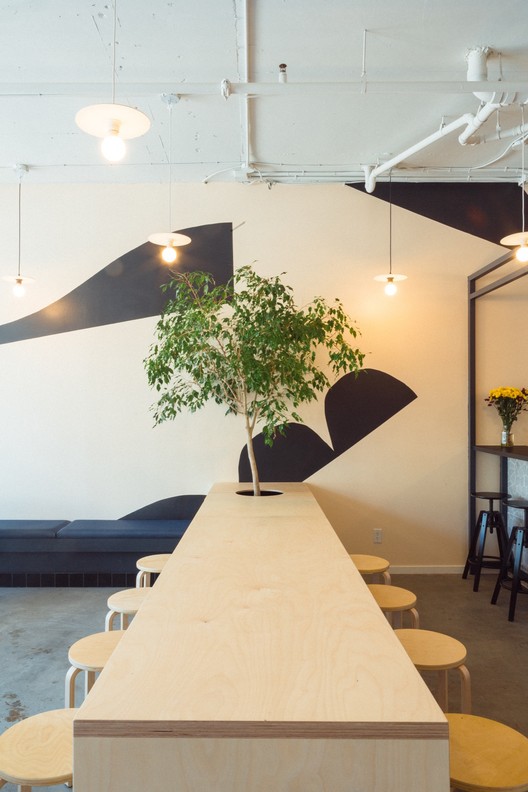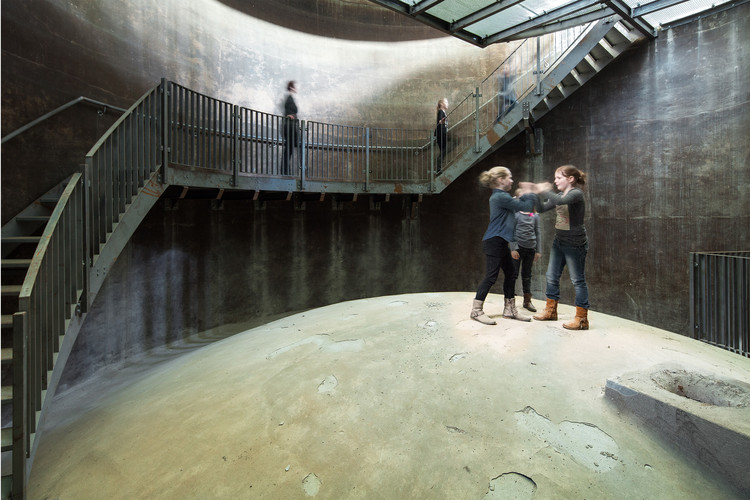Alliander HQ RAU architects
2015-11-26 04:00
架构师提供的文本描述。能源电网公司Alliander在Duiven(荷兰)的新总部最近正式成立。RAU建筑师负责现有建筑物和扩建部分的翻修,扩建部分将容纳1550名工人。这是荷兰第一个获得BREEAM-NL杰出可持续性证书的翻新项目。
Text description provided by the architects. The new head office for the energy grid company Alliander in Duiven (The Netherlands) was recently inaugurated. RAU architects is responsible for the renovation of the existing buildings and the extension, which will house 1550 workers. This is the first renovation project in The Netherlands to obtain the BREEAM-NL outstanding sustainability certificate.
互联互通是设计的主要原则,适用于其所有部件和各级工程。现有的建筑物由不同的积木组成,受到尊重并融入到新的设计中,现有建筑中有多达83%的建筑仍然存在。一个由标志性屋顶覆盖的大型中庭在视觉上、编程上以及后勤上将六个不同的空间连接起来,并创建了一个“中间”的空间,供员工和游客见面。在弯曲的屋顶上放置了大天窗,以增加中庭的日光量,而立面完全是用玻璃建造的,与景观形成了牢固的联系,有助于形成一个健康而鼓舞人心的工作空间。
Interconnectivity was the main principle for the design and applies for all its parts and works on all levels. The existing buildings, which were composed of different blocks, are respected and integrated into the new design: up to 83% of the existing constructions remain. A large atrium covered by an iconic roof connects the six different volumes visually, programmatically as well as logistically, and creates an “in between” space where employees and visitors can meet. Large skylights are placed on the curved roof in order to increase the amount of daylight in the atrium and the façade is fully built of glass, creating a strong link with the landscape, contributing to a healthy and inspiring workspace.
维护现有建筑物的立面,包括窗户,并在其上贴上“表皮”,提高隔热价值,避免热量损失,减少能源需求。在朝向中庭的两侧,可以打开的更大的窗户被放置,与中庭产生了密切的视觉关系,并允许自然通风。
The facades of the existing buildings are maintained, including the windows, and a “skin” is attached to them, improving the insulation value, avoiding heat losses and reducing the energy demand. On the sides, which are oriented towards the atrium, larger windows, which can be opened, are placed, creating a close visual relation with the atrium and allowing natural ventilation.
效率和有效性是贯穿整个设计的指导原则。在干预、物质使用、足迹、成本和环境负担方面。作为回报,功能、舒适、创新、身份认同和对社会的积极影响得以实现。
Efficiency and effectiveness are guiding principles throughout the design. In intervention, material use, footprint, costs and burdening of the environment. In return, functionality, comfort, innovation, identity and a positive impact on society are achieved.
在许多方面,圆形一直是设计的一个组成部分:尊重大多数现有建筑,使用废弃木材作为立面,将被拆除部分的混凝土再利用,将钢结构用于扩建建筑物,从现有屋顶回收沥青,再利用现有厕所和天花板,以及将现有的门改装成新家具等等。屋顶上的金属结构是在过山车施工组的帮助下设计的,使其重量最小化,从而减少了原材料的不必要使用,并允许拆卸以供以后再使用。为了保证将来所有材料的再利用,我们制作了“原材料护照”。本文件载有关于翻新过程中添加的所有原材料、新装置和已经存在的现有材料的信息。它包括关于谁处理了这些材料,它们被暂时储存在哪里,以及它们可以被重用的方式的信息。
Circularity has been an integral part of the design in many ways: respecting the majority of the existing constructions, using waste wood for the facades, reusing the concrete from the parts which were demolished, reusing the steel construction for the extensions of the buildings, recycling the asphalt from the existing roofs, reusing the existing toilets and ceiling plates and converting the existing doors into new furniture, amongst other things. The metal structure from the roof is designed with the help of a roller coaster construction group, minimalizing its weight, thus reducing the unnecessary use of raw materials and allowing disassembly for later reuse. A “raw material passport” is made in order to assure the reuse of all the materials in the future. This document contains information on all the raw materials, which are added during the renovation, the new installations, and the existing materials which where already there. It includes information about who has handled the materials, where they were temporarily stored and ways in which they can be reused.
建筑建筑群提供的能源比需要的要多,周围的“邻居”可以通过智能电网使用这些能源,从而在社区建立一个绿色联盟。建筑物的设计优化了能源的使用,屋顶的设计刺激了自然通风,中庭成为密闭空间的“第二皮肤”,创造了一种介于两者之间的气候,从而优化了能源的使用。
The building complex provides more energy than needed, which can be used by “neighbours” in the surroundings through the Smart Grid, starting a Green Alliance in the community. The design of the building optimizes the use of energy, the design of the roof stimulates natural ventilation, and the atrium becomes a “second skin” for the closed volumes, creating an in between climate which optimizes the energy use.
由于使用太阳能电池板和地下水进行蓄热,它也是二氧化碳中性的。太阳能电池板被放置在停车场,作为汽车的遮阳和保护,使它们具有双重功能。由于这些都是第一位的,所以在荷兰有可能第一次建成一个具有能源效益的建筑工地。
Thanks to the use of solar panels and underground water for thermal storage, it is also CO2 neutral. The solar panels are placed in the parking as shading and protection for the cars, giving them a double function. Since these were placed first, it was possible to achieve an energy positive building site for the first time in the Netherlands.
The consortium for the Design & Build of Alliander in Duiven consists of VolkerWessels Vastgoed, Rau Architecten, Fokkema & Partners, Innax, Kuiper Compagnons, Van Rossum R.I., Boele&vanEesteren, Homij and Turntoo.
 举报
举报
别默默的看了,快登录帮我评论一下吧!:)
注册
登录
更多评论
相关文章
-

描边风设计中,最容易犯的8种问题分析
2018年走过了四分之一,LOGO设计趋势也清晰了LOGO设计
-

描边风设计中,最容易犯的8种问题分析
2018年走过了四分之一,LOGO设计趋势也清晰了LOGO设计
-

描边风设计中,最容易犯的8种问题分析
2018年走过了四分之一,LOGO设计趋势也清晰了LOGO设计










































































